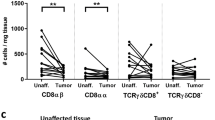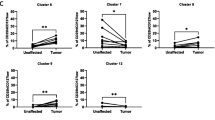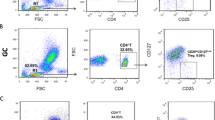Abstract
Radiation enteritis is one of the most common side effects of ionizing radiation in patients with pelvic cancers. Increasing amounts of evidence indicate that pro-inflammatory responses significantly contribute to the development of radiation enteritis. In this study, we investigated the association between T regulatory (Treg) cells and the risk of developing radiation enteritis in cervical cancer patients. The following observations were made. First, the frequencies of CD25hiFoxp3+ Treg cells were significantly lower in patients with radiation enteritis than in both healthy subjects and cervical cancer patients without radiation enteritis. Also, patients with the more severe grade 3 enteritis presented significantly lower Treg levels than patients with the more common grade 1 enteritis. Second, the expression of several molecules associated with Treg function, including CTLA-4, IL-10, TGF-β, and perforin, was significantly lower in patients with radiation enteritis than in healthy subjects. In patients without radiation enteritis, however, only CTLA-4, but not other Treg-associated suppressive molecules, was reduced in Treg cells. Third, Treg cells can markedly suppress CD8 T cell proliferation, but in patients with radiation enteritis, this function of Treg cells was significantly impaired, in a manner that was associated with lower CTLA-4 expression. Overall, these data suggest that the frequency and function of Treg cells is negatively associated with the risk of developing enteritis following radiation. In clinical practice, the characteristics of Treg cells may be considered to evaluate the risk of developing enteritis if the cancer patient is receiving ionizing radiation.





Similar content being viewed by others
References
Belyakov OV, Mitchell SA, Parikh D, Randers-Pehrson G, Marino SA, Amundson SA, et al. Biological effects in unirradiated human tissue induced by radiation damage up to 1 mm away. Proc Natl Acad Sci U S A. 2005;102(40):14203–8.
Eriksson D, Stigbrand T. Radiation-induced cell death mechanisms. Tumor Biol. 2010;31(4):363–72.
Andreyev HJN, Wotherspoon A, Denham JW, Hauer-Jensen M. “Pelvic radiation disease”: new understanding and new solutions for a new disease in the era of cancer survivorship. Scand J Gastroenterol. 2011;46(4):389–97.
Peterson LW, Artis D. Intestinal epithelial cells: regulators of barrier function and immune homeostasis. Nat Rev Immunol. 2014;14(3):141–53.
van der Flier LG, Clevers H. Stem cells, self-renewal, and differentiation in the intestinal epithelium. Annu Rev Physiol. 2009;71:241–60.
Bentzen SM. Preventing or reducing late side effects of radiation therapy: radiobiology meets molecular pathology. Nat Rev Cancer. 2006;6(9):702–13.
Polistena A, Johnson LB, Ohiami-Masseron S, Wittgren L, Bäck S, Thornberg C, et al. Local radiotherapy of exposed murine small bowel: apoptosis and inflammation. BMC Surg. 2008;8:1.
Ong ZY, Gibson RJ, Bowen JM, Stringer AM, Darby JM, Logan RM, et al. Pro-inflammatory cytokines play a key role in the development of radiotherapy-induced gastrointestinal mucositis. Radiat Oncol. 2010;5:22.
Wang J, Boerma M, Fu Q, Hauer-Jensen M. Significance of endothelial dysfunction in the pathogenesis of early and delayed radiation enteropathy. World J Gastroenterol. 2007;13(22):3047–55.
François A, Milliat F, Guipaud O, Benderitter M. Inflammation and immunity in radiation damage to the gut mucosa. Biomed Res Int. 2013;2013:123241.
Kuku S, Fragkos C, Mccormack M, Forbes A. Radiation-induced bowel injury: the impact of radiotherapy on survivorship after treatment for gynaecological cancers. Br J Cancer. 2013;109(6):1504–12.
Zhao H, Liao X, Kang Y. Tregs: where we are and what comes next? Front Immunol. Frontiers. 2017;8:1578.
Schmidt A, Oberle N, Krammer PH. Molecular mechanisms of treg-mediated T cell suppression. Front Immunol. Frontiers Media SA. 2012;3:51.
Qureshi OS, Zheng Y, Nakamura K, Attridge K, Manzotti C, Schmidt EM, et al. Trans-endocytosis of CD80 and CD86: a molecular basis for the cell-extrinsic function of CTLA-4. Science Europe PMC Funders. 2011;332:600–3.
Abayomi J, Kirwan J, Hackett A. The prevalence of chronic radiation enteritis following radiotherapy for cervical or endometrial cancer and its impact on quality of life. Eur J Oncol Nurs. 2009;13(4):262–7.
Cox JD, Stetz J, Pajak TF. Toxicity criteria of the radiation therapy oncology group (RTOG) and the European organization for research and treatment of cancer (EORTC). Int J Radiat Oncol Biol Phys. 1995;31(5):1341–6.
Tiemessen MM, Jagger AL, Evans HG, Van Herwijnen MJC, John S, Taams LS. CD4+CD25+Foxp3+ regulatory T cells induce alternative activation of human monocytes/macrophages. Proc Natl Acad Sci U S A. 2007;104(49):19446–51.
Collison LW, Vignali DAA. In vitro Treg suppression assays. Methods Mol Biol. 2011;707:21–37.
Shadad AK, Sullivan FJ, Martin JD, Egan LJ. Gastrointestinal radiation injury: prevention and treatment. World J Gastroenterol. 2013;19(2):199–208.
Tanaka A, Sakaguchi S. Regulatory T cells in cancer immunotherapy. Cell Res. 2017;27(1):109–18.
Curiel TJ. Tregs and rethinking cancer immunotherapy. J Clin Invest American Society for Clinical Investigation. 2007;117:1167–74.
Qu Y, Jin S, Zhang A, Zhang B, Shi X, Wang J, et al. Gamma-ray resistance of regulatory CD4 + CD25 + Foxp3 + T cells in mice. Radiat Res. 2010;173(2):148–57.
Anderson BE, McNiff JM, Matte C, Athanasiadis I, Shlomchik WD, Shlomchik MJ. Recipient CD4+ T cells that survive irradiation regulate chronic graft-versus-host disease. Blood. 2004;104(5):1565–73.
Muroyama Y, Nirschl TR, Kochel CM, Lopez-Bujanda Z, Theodros D, Mao W, et al. Stereotactic radiotherapy increases functionally suppressive regulatory T cells in the tumor microenvironment. Cancer Immunol Res. 2017;5(11):992–1004.
Qureshi OS, Zheng Y, Nakamura K, Attridge K, Manzotti C, Schmidt EM, et al. Trans-endocytosis of CD80 and CD86: a molecular basis for the cell-extrinsic function of CTLA-4. Science. 2011;332:600–3.
Corthay A. How do regulatory T cells work? Scand J Immunol. 2009;70:326–36.
Funding
This work was supported by Huzhou Science and Technology Plan Project (2018GY09).
Author information
Authors and Affiliations
Corresponding author
Ethics declarations
Conflict of interest
The authors declare that they have no conflict of interest.
Ethical Approval
Ethical approval was received from the Ethics Committee of Zhebei Mingzhou Hospital.
Statement of informed consent
All study participants gave written informed consent for the collection of clinical data and peripheral blood mononuclear cell (PBMC) samples.
Additional information
Publisher’s note
Springer Nature remains neutral with regard to jurisdictional claims in published maps and institutional affiliations.
Rights and permissions
About this article
Cite this article
Gong, X., Yu, G., Song, Z. et al. Patients with radiation enteritis present regulatory T cell impairment associated with CTLA-4. Immunol Res 68, 179–188 (2020). https://doi.org/10.1007/s12026-020-09142-8
Published:
Issue Date:
DOI: https://doi.org/10.1007/s12026-020-09142-8




